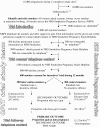The cessation in pregnancy incentives trial (CPIT): study protocol for a randomized controlled trial
- PMID: 22818493
- PMCID: PMC3482147
- DOI: 10.1186/1745-6215-13-113
The cessation in pregnancy incentives trial (CPIT): study protocol for a randomized controlled trial
Abstract
Background: Seventy percent of women in Scotland have at least one baby, making pregnancy an opportunity to help most young women quit smoking before their own health is irreparably compromised. By quitting during pregnancy their infants will be protected from miscarriage and still birth as well as low birth weight, asthma, attention deficit disorder and adult cardiovascular disease. In the UK, the NICE guidelines: 'How to stop smoking in pregnancy and following childbirth' (June 2010) highlighted that little evidence exists in the literature to confirm the efficacy of financial incentives to help pregnant smokers to quit. Its first research recommendation was to determine: Within a UK context, are incentives an acceptable, effective and cost-effective way to help pregnant women who smoke to quit?
Design and methods: This study is a phase II exploratory individually randomized controlled trial comparing standard care for pregnant smokers with standard care plus the additional offer of financial voucher incentives to engage with specialist cessation services and/or to quit smoking during pregnancy.Participants (n = 600) will be pregnant smokers identified at maternity booking who, when contacted by specialist cessation services, agree to having their details passed to the NHS Smokefree Pregnancy Study Helpline to discuss the trial. The NHS Smokefree Pregnancy Study Helpline will be responsible for telephone consent and follow-up in late pregnancy. The primary outcome will be self reported smoking in late pregnancy verified by cotinine measurement. An economic evaluation will refine cost data collection and assess potential cost-effectiveness while qualitative research interviews with clients and health professionals will assess the level of acceptance of this form of incentive payment. The research questions are: What is the likely therapeutic efficacy? Are incentives potentially cost-effective? Is individual randomization an efficient trial design without introducing outcome bias? Can incentives be introduced in a way that is feasible and acceptable?
Discussion: This phase II trial will establish a workable design to reduce the risks associated with a future definitive phase III multicenter randomized controlled trial and establish a framework to assess the costs and benefits of financial incentives to help pregnant smokers to quit.
Trial registration: Current Controlled Trials ISRCTN87508788.
Figures


References
-
- Gray R, Bonellie SR, Chalmers J, Greer I, Jarvis S, Kurinczuk JJ, Williams C. Contribution of smoking during pregnancy to inequalities in stillbirth and infant death in Scotland 1994–2003: retrospective population based study using hospital maternity records. BMJ. 2009;339:b3754. doi: 10.1136/bmj.b3754. - DOI - PMC - PubMed
-
- NHS Quality Improvement Scotland. Scottish Perinatal and Infant Mortality and Morbidity Report 2004. Scottish Programme for Clinical Effectiveness in Reproductive Health, Edinburgh; 2005. http://www.isdscotland.org/isd/files/mat_spimmr2004_2.pdf.
-
- Information Services Division NHS National Services Scotland. Births and Babies: Smoking and pregnancy. 2009. http://www.isdscotland.org/isd/2911.html.
Publication types
MeSH terms
Associated data
Grants and funding
LinkOut - more resources
Full Text Sources
Medical

